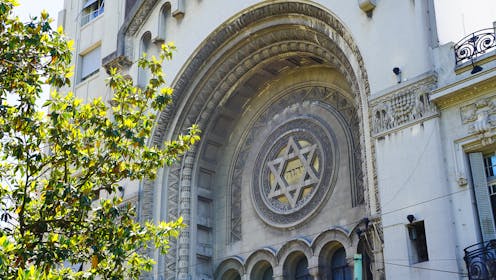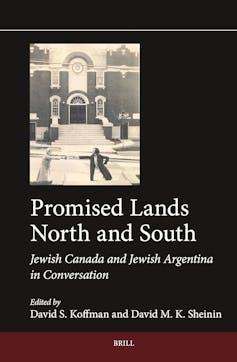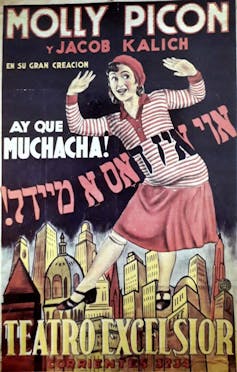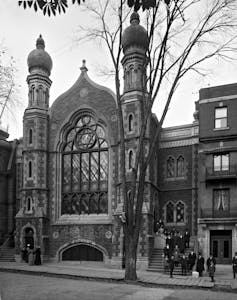
After the United States, Argentina and Canada are home to two of the largest Jewish communities in the Americas. While there are multiple parallels between the two communities in terms of culture and history, Jewish life in Canada and Argentina also varies. It has been influenced by larger national changes that have moulded communities, neighbourhoods, ideologies, identities and more.
These differences reflect the diversity of Jewish communities globally. Perhaps most importantly, Jewish experience reflects the political, social and economic evolution of each country throughout the 20th century.
York University professor David S. Koffman and I recently co-edited the book, Promised Lands North and South: Jewish Canada and Jewish Argentina in Conversation, which is the first to comparatively explore Jewish communities in the two countries, Argentina and Canada.
Read more: Young, Canadian and Jewish: The shift from religious to cultural identity
Becoming Argentines & Canadians

Jewish immigration to both countries happened at roughly the same time — colonial-era waves around the turn of the 18th century of Sephardi Jews from Spain, the Middle East and North Africa; much larger waves of Ashkenazi European Jews from the 1880s to the 1920s; and smaller waves of post-Second World War migrants from the Middle East, North Africa and elsewhere.
Our book explores how Jews “became” Argentine or Canadian based on how they joined national work forces, claimed neighbourhood and political identities, responded to discrimination and shaped Jewish identity in varied contexts.
Jewish communities in Argentina and Canada evolved in conjunction with larger national changes. By entering the public sphere, Jewish Argentines and Canadians contributed to national historical narratives and what it meant to be a citizen of each place.
Comparative examples of similarities and differences in the Jewish experience explored in this volume include the evolution of Yiddish-language theatre in each country; Jewish attention to the anti-fascist Spanish author Federico García Lorca; and Jewish ties to populist movements.
Both countries were built on the destruction of Indigenous Peoples and European economic templates. Both saw enormous wealth generated thanks to dynamic agricultural sectors that drew on the poorly paid labour of working people.
In both countries, Jewish immigrants arrived for the most part as working-class labourers, and there were Jewish settlements in the rural plains that for the most part lasted only one generation.
Economics and the arts
As in New York and Philadelphia, Yiddish-language theatre in Montréal, Toronto and Buenos Aires was a cultural cornerstone of the early 20th-century Jewish urban experience.
While Canada thrived on the doorstep of the U.S. economy in the 20th century, the Argentine economy began to languish in the 1920s. Like the rest of the country, the Jewish community suffered the impacts of this decline.
The popular Yiddish-language theatre movement did persist later into the 20th century in Buenos Aires than in Montréal. But facing financial strictures, the Argentine theatre relied more heavily on poorly paid local performers.

This was based in part on geographic distance from the northern hemisphere. Over time, the Argentine movement relied less on artists from abroad and more on local troupes. While Yiddish theatre survives in both countries, it is no longer the widely popular form of entertainment it once was.
Economic conditions in Argentina worsened throughout the 20th century, eventually giving way to political violence. The changing political and economic currents are reflected in the work of the country’s Jewish writers and scholars.
Reina Roffé, Samuel Calamaro and other Argentine Jewish authors have focused on the meaning of class and politics in García Lorca’s work (particularly internationalism and fascism). Meanwhile, Canadian Jewish authors have focused more on his understanding of ethnicity, gender and masculinity.
Response to populism
One similarity the Jewish communities share is their response to populist politics. In both countries, many Jews opposed radical populist political movements, seeing them as antithetical to liberal democratic traditions.
Moreover, in both Argentina and Canada, a mythology unfolded in the aftermath of German Nazism suggesting that all Jews shunned populism as linked to right-wing fanaticism and antisemitism.
In our book, we note how Peronism — the movement led by Argentine president Juan Perón in the 1940s and 50s — drew Jewish adherents. Many were supportive of Perón’s assertion that Argentine identity and citizenship drew no distinctions on the basis of ethnicity or religion.

A similar Jewish antipathy for populism developed in Canada, even though many anglophone Jews strongly supported the nationalist aspirations of francophone Québécois in the 1960s. Likewise, English-speaking Jewish communities in Québec viewed the aspirations of their francophone neighbours in contexts similar to their own struggles against discrimination.
By the 1970s, most antisemitic constraints on Jewish Canadians had dissipated. However, in Argentina, Jews continued to face discriminatory practices through the beginning of the 21st century. Those included a prohibition against non-Catholics serving as president that was lifted as part of the 1994 amendment to the constitution.
In 2002, then-foreign minister, Carlos Ruckauf, appointed an ambassador to the Argentine Jewish community, as though Jews were a foreign group. No explanation from the foreign ministry was ever offered for the appointment. An outpouring of opposition to Ruckauf followed in the Argentine media from both Jews and non-Jews.
Argentine Jews come to Canada
Once a city with a growing Jewish community, Winnipeg had seen a steady decrease in the Jewish population as Canadians from the Prairie provinces migrated to more prosperous urban environments in Vancouver, Toronto and elsewhere.
Among Jewish Manitobans, this produced a sense of concern over the possible disappearance of the province’s Jewish community. But more immediately, there was a concern that elderly people living in community-based retirement homes would not have access to sufficient health-care professionals.
In 1995, the Winnipeg Jewish community encouraged Jewish Argentines to emigrate to the city. The move signalled the end of a long divergence where, by and large, Jewish Canadians and Argentines lived in increasingly disparate socioeconomic contexts.
The solution seemed perfect to all parties. Jewish Argentines, overwhelmed by persistent economic crises, might find a home in Canada while the longstanding Winnipeg Jewish community might find new life through the Argentine arrivals. When the Winnipeg Jewish community faced what seemed an insurmountable demographic challenge, it found a solution in Jewish Argentina.
David M. K. Sheinin does not work for, consult, own shares in or receive funding from any company or organisation that would benefit from this article, and has disclosed no relevant affiliations beyond their academic appointment.
This article was originally published on The Conversation. Read the original article.







